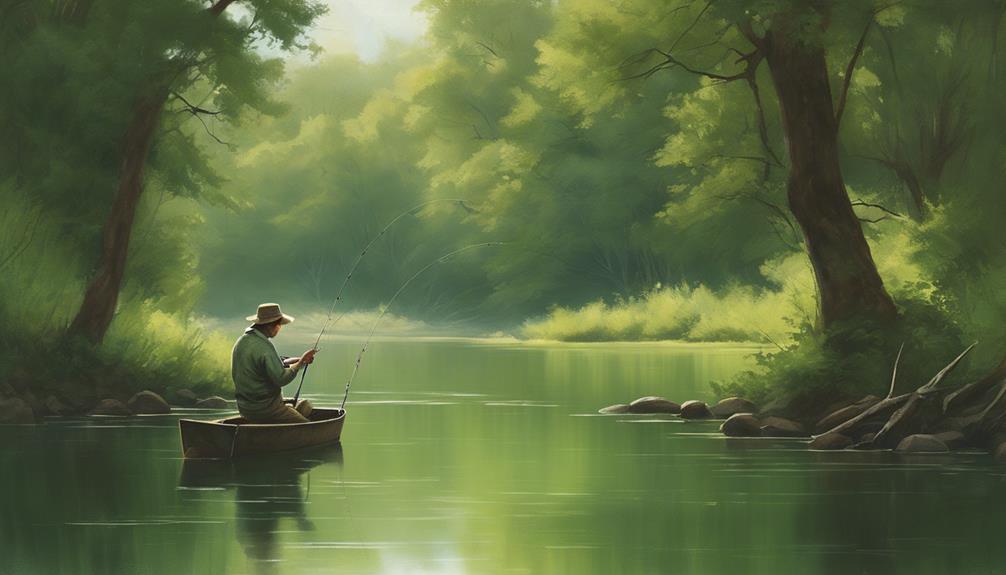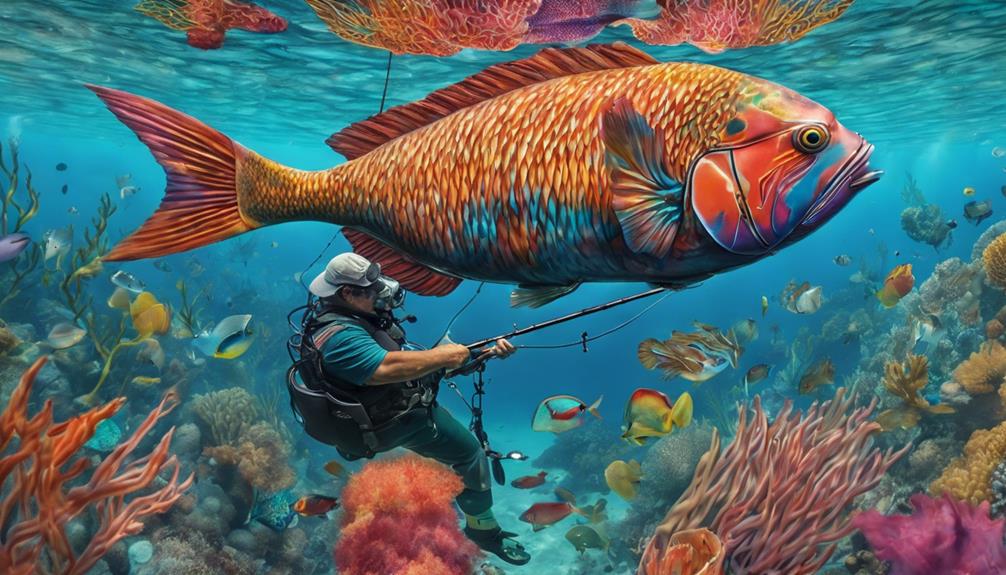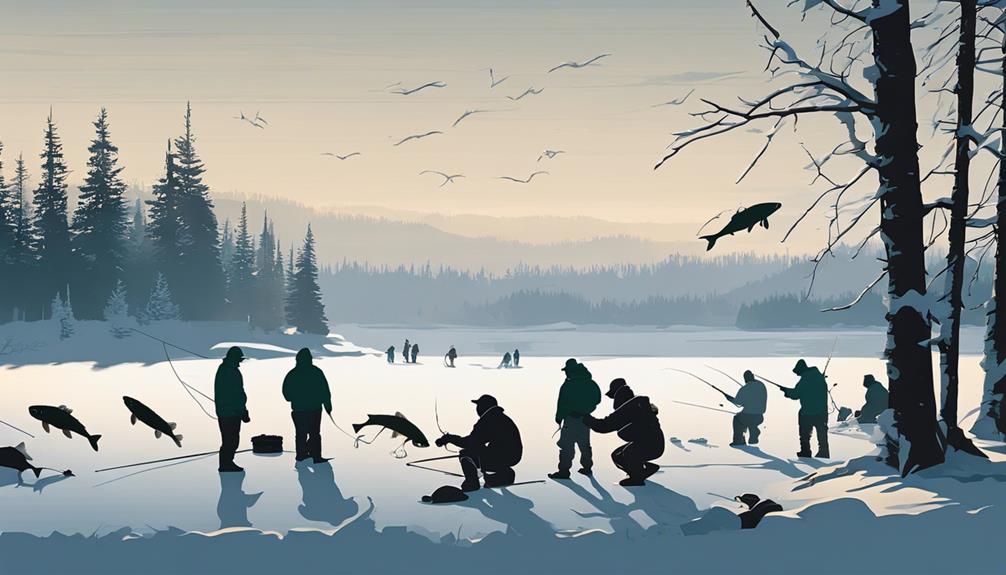Picture yourself as a modern-day angler navigating the rivers, equipped not just with a rod and reel, but also with the knowledge of your target species. However, catching that elusive trophy fish requires more than just luck and skill.
What if you could enhance your angling experience by focusing on four key tips specifically tailored to different river-dwelling species? Stay tuned to discover the secrets that could transform your next fishing expedition into a truly successful and rewarding adventure.
Understanding the Target Species
To successfully catch specific fish species while angling, you must first understand their habits and preferences. Species behavior plays a crucial role in determining where and when you should fish for them. Each fish species has its unique traits and tendencies that influence their feeding patterns and movements in the water. By gaining habitat knowledge, you can increase your chances of a successful catch.
Different fish species exhibit varied behaviors based on factors like water temperature, time of day, and available food sources. For instance, trout are known to be more active in cooler water temperatures and often seek shelter in areas with underwater structures like rocks or fallen trees. On the other hand, bass tend to be more aggressive predators, preferring to hunt for prey in shallower waters near vegetation.
Understanding the habitat preferences of specific fish species is essential for effective angling. By knowing where certain species are likely to be found in a river, you can strategically position yourself to increase your chances of a successful catch. For example, if you're targeting catfish, you may want to focus your efforts near the riverbed where they usually scavenge for food. By combining species behavior and habitat knowledge, you can tailor your angling approach to maximize your success on the water.
Selecting the Right Gear
When preparing for river angling, ensure you choose gear that matches the specific needs of the target species you aim to catch. Proper gear selection is crucial for a successful fishing trip. Here are some tips to help you select the right gear and use proper techniques:
- Research the Species: Before heading out, research the specific species you're targeting. Different fish have different behaviors and habitats, so understanding your target will help you choose the appropriate gear.
- Matching Rod and Reel: Make sure your rod and reel are suitable for the size and fighting characteristics of the fish you're targeting. A light rod may not be able to handle a large, powerful fish.
- Selecting the Right Bait: Choose bait that's known to attract the species you're after. Whether it's live bait or artificial lures, make sure it mimics the natural prey of the fish.
- Adjusting Techniques: Be prepared to adjust your techniques based on the behavior of the fish. Sometimes a change in retrieval speed or depth can make all the difference in getting a bite.
Identifying Key River Features
Navigating the river's twists and turns will reveal key features crucial for successful angling expeditions. Keep an eye out for meandering channels that often hold a variety of fish species seeking refuge from strong currents. These slower-moving sections are ideal for setting up your fishing spot. Deep pools are another hotspot to look out for. These areas provide shelter and are usually home to larger fish looking for prey.
Rocky riffles are areas where the water cascades over rocks, creating oxygen-rich environments that attract fish in search of food. Casting your line near these riffles can yield great results. Undercut banks are also prime locations to target. These areas offer cover for fish to hide from predators and ambush passing prey.
When scouting for these key features, pay attention to the flow of the river and how different structures influence the movement of fish. By understanding the layout of the river and the habitats it offers, you can strategically position yourself for a successful angling experience. Take note of any changes in the river's depth, speed, and structure as these can indicate where fish are likely to be located. Mastering the art of identifying these key river features will greatly enhance your chances of landing the perfect catch.
Mastering Species-Specific Baits
Keep a keen eye on the specific baits that work best for different fish species to enhance your angling success. Bait selection plays a crucial role in attracting specific types of fish, so it's essential to experiment with different baits to see what works best for each species.
Here are four tips to help you master species-specific baits and improve your chances of a successful fishing trip:
- Research and Observation: Take the time to research the preferred diet of the fish species you're targeting. Observe the natural food sources available in the river to get an idea of what bait to use.
- Adapt Your Bait: Be prepared to adapt your bait selection based on the fishing conditions and the behavior of the fish. Sometimes, fish might be more responsive to live bait, while other times they may prefer artificial lures.
- Experiment with Presentation: Different fish species have varying feeding behaviors. Experiment with different fishing techniques to see what attracts the fish's attention. This could involve adjusting the depth of your bait, the speed of retrieval, or the movement of your bait.
- Stay Informed: Stay up to date on local fishing reports and talk to fellow anglers to gather insights on successful bait choices. Fishing techniques and bait preferences can vary from one river to another, so local knowledge can be invaluable.
Perfecting Your Casting Techniques
To enhance your angling success further, honing your casting techniques is crucial when targeting specific fish species in the river. Improving accuracy and increasing distance are key elements to consider when perfecting your casting techniques.
Firstly, to improve accuracy, focus on your wrist action. A controlled wrist movement helps direct your cast to the desired spot, especially when aiming for specific areas where certain fish species are known to lurk. Practice your wrist flick to land your bait precisely where you want it.
Secondly, work on increasing your casting distance. This can be achieved by mastering the technique of loading and unloading the rod correctly. Make sure to generate enough power during the casting motion to propel your bait further into the river. Experiment with different casting angles to find what works best for you in different river conditions.
Additionally, consider the weight of your bait and adjust your casting strength accordingly. Lighter baits may require a gentler cast, while heavier baits might need a more forceful throw. By understanding how different baits interact with your casting technique, you can optimize your chances of attracting specific fish species.
Adapting to River Conditions
Consider adjusting your fishing strategy based on the current river conditions to maximize your chances of a successful angling experience. Understanding how water temperature affects fish behavior is crucial for adapting your approach.
Here's how you can do it effectively:
- Monitor Water Temperature: Fish are cold-blooded creatures, meaning their activity levels are influenced by water temperature. In warmer waters, fish tend to be more active and may swim to shallower areas. Conversely, in colder temperatures, they might seek deeper, warmer spots. Use this knowledge to target the right areas.
- Adjust Your Bait: Different fish species have preferences for water temperatures. If you know the species you're targeting prefers warmer waters, consider using bait that mimics the behavior of their natural prey in those conditions. This can increase your chances of attracting bites.
- Time Your Fishing: Fish are often more active during specific times of the day, which can be influenced by water temperature. For instance, during colder mornings, fish may be less active and feeding, while they might be more active during warmer afternoons. Plan your angling trips accordingly.
- Observe Fish Behavior: Pay attention to how the fish are behaving. If you notice they're sluggish or staying in deeper waters, it might be an indication that the water is colder. Conversely, if they're actively feeding near the surface, the water temperature is likely warmer, and you should adjust your tactics accordingly.
Practicing Patience and Persistence

Practicing patience and persistence is key to honing your angling skills and achieving success in river fishing. Mental preparation plays a crucial role in maintaining focus while waiting for the perfect catch. Before heading out, visualize yourself in different scenarios, preparing your mind for the challenges ahead. Timing is everything in river angling, so be patient and persistent even when the fish aren't biting right away. Remember, good things come to those who wait.
Endurance is another essential trait for successful river angling. Fishing can be physically demanding, requiring you to stay alert and active for extended periods. Stay hydrated, take breaks when needed, and maintain your energy levels to ensure you're at the top of your game. Focus on the task at hand, block out distractions, and be ready to react quickly when the moment arrives. Developing endurance won't only improve your angling skills but also enhance your overall experience on the river.
Respecting Catch and Release Guidelines
Maintaining respect for catch and release guidelines is crucial for preserving fish populations and sustaining the ecosystem balance in river angling. By following these guidelines, you can ensure fish conservation and practice ethical angling while contributing to wildlife preservation and responsible fishing.
Here are four essential tips to help you respect catch and release guidelines effectively:
- Use barbless hooks: Barbless hooks cause less damage to the fish, making it easier to release them safely back into the water. This simple adjustment can significantly reduce harm to the fish during the catch and release process.
- Handle with care: Minimize the time you handle the fish by keeping it in the water as much as possible. Wet your hands before touching the fish to protect its delicate skin and avoid removing its protective slime layer.
- Avoid overplaying the fish: Fight the fish efficiently to prevent exhaustion, which can decrease its chances of survival after release. Use appropriate gear and techniques to shorten the fight time and reduce stress on the fish.
- Revive before release: If needed, revive the fish by gently moving it back and forth in the water to ensure proper oxygen flow through its gills. Release the fish only when it can swim away on its own, indicating it has recovered from the catch.
Frequently Asked Questions
How Can I Effectively Locate the Best Fishing Spots Within a River for a Specific Species?
When trying to find the best fishing spots within a river for a specific species, you should focus on equipment selection and spotting signs that indicate where the fish might be.
Reading currents can also help you pinpoint these areas.
What Are Some Common Mistakes Anglers Make When Targeting a Specific Species in a River?
When targeting a specific species in a river, common mistakes include overlooking river conditions and not adapting to the changing environment.
Choosing the wrong equipment for the river structure can hinder your success. To avoid these errors, stay informed about the water conditions, adjust your gear accordingly, and pay attention to how the river's structure influences the behavior of the species you're targeting.
Are There Any Specific Regulations or Restrictions I Should Be Aware of When Fishing for Certain Species in a River?
When fishing for specific species in a river, be sure to check gear requirements and conservation measures. Additionally, consider bait selection and catch limits to stay within regulations.
How Can I Improve My Chances of Catching Larger or More Elusive Species in a River?
To improve your chances of catching larger or more elusive species in a river, focus on bait selection and river conditions. Opt for appropriate gear setup and practice precise casting techniques.
What Are Some Advanced Techniques or Strategies for Targeting Specific Species in a River That Experienced Anglers Use?
To target specific species in a river like a pro, focus on bait selection and casting accuracy. Master river navigation and understand fish behavior.
By honing these techniques, you can increase your chances of landing the species you're after. Stay patient and observant, adjusting your approach based on the conditions and the behavior of the fish.
With practice, you'll improve your skills and reel in those elusive catches.
Conclusion
Now that you have learned these four tips for successful species-specific river angling, you're ready to hit the water with confidence.
By understanding your target species, selecting the right gear, identifying key river features, and mastering species-specific baits, you can increase your chances of a successful fishing trip.
Remember to practice patience, adapt to river conditions, and always respect catch and release guidelines for a fulfilling angling experience.
Happy fishing!



